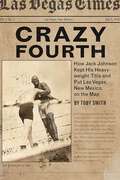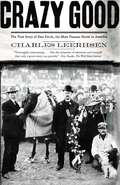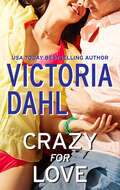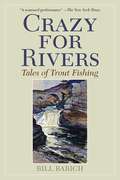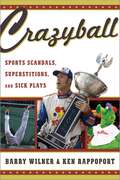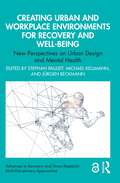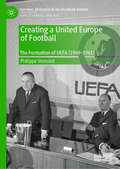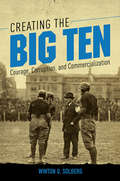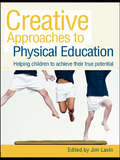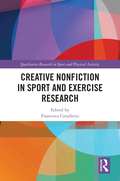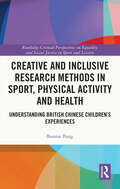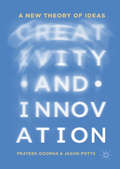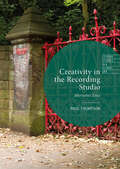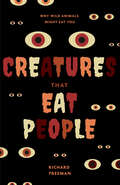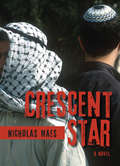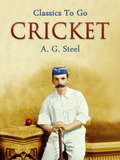- Table View
- List View
Crazy Blood: A Novel
by T. Jefferson Parker"A brave and daring writer." —Lisa See, New York Times bestselling author of Shanghai GirlsThe Carson dynasty rules the ski resort town of Mammoth Lakes in the Sierra Nevada Mountains in California. Founded by patriarch Adam, the town is the site of the Mammoth Cup ski race-a qualifier for the Olympics. But when Wylie Welborn, Adam's illegitimate grandson, returns after a stint in Afghanistan, it reopens a dark moment in Carson family history: the murder of Wylie's father by his jealous and very pregnant wife, Cynthia. Her son Sky, born while his mother was in prison, and Wylie are half-brothers. They inherit not only superb athletic skills but an enmity that threatens to play out in a lethal drama on one of the fastest and most perilous ski slopes in the world. Three powerful and unusual women have central roles in this volatile family feud: Cynthia, bent on destroying Wylie; his mother Kathleen, determined to protect him; and April Holly, a beautiful celebrity snowboarder, on track to win Olympic Gold. But, as Wylie falls in love with April and they begin to imagine a life away from the violence that has shattered his family, history threatens to repeat itself and destroy them both.Combining exquisite writing with breathtaking scenes of high stakes skiing, T. Jefferson Parker's Crazy Blood is an unforgettable story of two brothers on a ruthless quest for supremacy.
Crazy Fourth: How Jack Johnson Kept His Heavyweight Title and Put Las Vegas, New Mexico, on the Map
by Toby SmithIn 1912 boxing was as popular a spectator sport in the United States as baseball, if not more so. It was also rife with corruption and surrounded by gambling, drinking, and prostitution, so much so that many cities and states passed laws to control it. But not in New Mexico. It was the perfect venue for one of the biggest, loudest, most rambunctious heavyweight championship bouts ever seen. In Crazy Fourth Toby Smith tells the story of how the African American boxer Jack Johnson—the bombastic and larger-than-life reigning world heavyweight champion—met Jim Flynn on the fourth of July in Las Vegas, New Mexico. The civic boosters, bursting with pride in their town, raised a hundred thousand dollars for the fight, pushing events like the sinking of the Titanic to the back pages of every newspaper. In the end, once the dust finally settled on the whole unseemly spectacle, Las Vegas would spend the next generation making good on its losses.
Crazy Good: The True Story of Dan Patch, the Most Famous Horse in America
by Charles LeerhsenA hundred years ago, the most famous athlete in America was a horse. But Dan Patch was more than a sports star; he was a cultural icon in the days before the automobile. Born crippled and unable to stand, he was nearly euthanized. For a while, he pulled the grocer's wagon in his hometown of Oxford, Indiana. But when he was entered in a race at the county fair, he won -- and he kept on winning. Harness racing was the top sport in America at the time, and Dan, a pacer, set the world record for the mile. He eventually lowered the mark by four seconds, an unheard-of achievement that would not be surpassed for decades. America loved Dan Patch, who, though kind and gentle, seemed to understand that he was a superstar: he acknowledged applause from the grandstands with a nod or two of his majestic head and stopped as if to pose when he saw a camera. He became the first celebrity sports endorser; his name appeared on breakfast cereals, washing machines, cigars, razors, and sleds. At a time when the highest-paid baseball player, Ty Cobb, was making $12,000 a year, Dan Patch was earning over a million dollars. But even then horse racing attracted hustlers, cheats, and touts. Drivers and owners bet heavily on races, which were often fixed; horses were drugged with whiskey or cocaine, or switched off with "ringers. " Although Dan never lost a race, some of his races were rigged so that large sums of money could change hands. Dan's original owner was intimidated into selling him, and America's favorite horse spent the second half of his career touring the country in a plush private railroad car and putting on speed shows for crowds that sometimes exceeded 100,000 people. But the automobile cooled America's romance with the horse, and by the time he died in 1916, Dan was all but forgotten. His last owner, a Minnesota entrepreneur gone bankrupt, buried him in an unmarked grave. His achievements have faded, but throughout the years, a faithful few kept alive the legend of Dan Patch, and inCrazy Good, Charles Leerhsen travels through their world to bring back to life this fascinating story of triumph and treachery in small-town America and big-city racetracks.
Crazy Good: The True Story of Dan Patch, the Most Famous Horse in America
by Charles LeerhsenA hundred years ago, the most famous athlete in America was a horse. But Dan Patch was more than a sports star; he was a cultural icon in the days before the automobile. Born crippled and unable to stand, he was nearly euthanized. For a while, he pulled the grocer's wagon in his hometown of Oxford, Indiana. But when he was entered in a race at the county fair, he won -- and he kept on winning. Harness racing was the top sport in America at the time, and Dan, a pacer, set the world record for the mile. He eventually lowered the mark by four seconds, an unheard-of achievement that would not be surpassed for decades. America loved Dan Patch, who, though kind and gentle, seemed to understand that he was a superstar: he acknowledged applause from the grandstands with a nod or two of his majestic head and stopped as if to pose when he saw a camera. He became the first celebrity sports endorser; his name appeared on breakfast cereals, washing machines, cigars, razors, and sleds. At a time when the highest-paid baseball player, Ty Cobb, was making $12,000 a year, Dan Patch was earning over a million dollars. But even then horse racing attracted hustlers, cheats, and touts. Drivers and owners bet heavily on races, which were often fixed; horses were drugged with whiskey or cocaine, or switched off with "ringers." Although Dan never lost a race, some of his races were rigged so that large sums of money could change hands. Dan's original owner was intimidated into selling him, and America's favorite horse spent the second half of his career touring the country in a plush private railroad car and putting on speed shows for crowds that sometimes exceeded 100,000 people. But the automobile cooled America's romance with the horse, and by the time he died in 1916, Dan was all but forgotten. His last owner, a Minnesota entrepreneur gone bankrupt, buried him in an unmarked grave. His achievements have faded, but throughout the years, a faithful few kept alive the legend of Dan Patch, and in Crazy Good, Charles Leerhsen travels through their world to bring back to life this fascinating story of triumph and treachery in small-town America and big-city racetracks.
Crazy Is My Superpower: How I Triumphed by Breaking Bones, Breaking Hearts, and Breaking the Rules
by A.J. Mendez BrooksRecently retired WWE superstar AJ Mendez Brooks is a powerhouse—strong, quirky, and totally confident. But that wasn’t always the case. With humor and tremendous heart, she opens up for the first time about her harrowing struggle to understand her demons and the diagnosis that helped her gain control over her life. Everything I was told should be my greatest insecurities and weaknesses, everything that I’ve been labeled—SHORT, NERDY, SKINNY, WEAK, IMPULSIVE, UGLY, TOMBOY, POOR, REBEL, LOUD, FREAK, CRAZY—turned out to be my greatest strengths. I didn’t become successful in spite of them. I became successful because of them. Growing up AJ was a quiet girl trying to act “normal” when she felt anything but. As her family struggled with drug addiction, poverty, and mental illness, she found escape through comic books and video games, and was inspired by the tough and unconventional female characters. It wasn’t until she discovered pro wrestling that she learned superheroes could be real. Determined to become the superhero she’d always admired, AJ trained and sacrificed for years to achieve her dream of wrestling professionally. Yet she quickly faced industry pressure to play the role of the damsel in distress and to dress more provocatively to cater to male fans. But she fought back and created an ass-kicking alter ego that was a genuine representation of herself: nerdy, enthusiastic, and a little bit crazy. With humor and tremendous heart, AJ opens up for the first time about her harrowing struggle to understand her demons and the mental illness diagnosis that helped her gain control over her life. What most people view as a hardship, AJ embraced as inspiration for her superhero persona, shattering the stigma attached to mental illness. Charting her journey from a scrappy girl in an unstable home to an empowered wrestling champion, Crazy Is My Superpower is an unflinchingly honest story and brave confessional about her long road to self-acceptance.
Crazy for Love
by Victoria DahlChloe Turner thought she was going to marry the perfect man-until her fiancé's plane crashed. And then she got the really bad news: he'd tried to fake his own death to avoid marrying her. Now America's most famous bridezilla (a tag she most definitely does not deserve), Chloe escapes to a remote island to avoid the paparazzi. And right next door is a man who just might be the cure for Chloe's heartache....A magnet for wild, complicated women, Max Sullivan is relieved to have finally found someone "normal." Chloe is his girl-next-door fantasy come to life, and best of all, she gets him. With her, he can be himself, a treasure-hunting millionaire who desperately wants out of his sexy but reckless job. But when Chloe's notoriety catches up with them, will their torrid romance make it to the mainland?
Crazy for Rivers
by Bill Barich"That autumn, I went a little crazy for rivers."So writes Bill Barich, and this charming volume captures the essence of obsession. The hours he spent on various streams became a meditation on family, friends, and the natural world. To anyone who remembers the infinite patience of a grandfather on a lake, or the romance of a mountain getaway with a new girlfriend; to anyone who can recall each fish caught on days that were far too hot, or way too cold, or on rivers too crowded, or in canyons too steep; to anyone who has appreciated the trust of an age-old fishing partner, or marveled at the beauty of a leaping trout-to anyone, in fact, who has ever gone a little crazy for rivers, Bill Barich's wonderful memories of a season on the water and a lifetime of fishing will seem both touching and wise. This little book is a gem.
Crazy for Rivers: Tales of Trout Fishing (Lyons Press Ser.)
by Bill Barich"That autumn, I went a little crazy for rivers.”So writes Bill Barich, and this charming volume captures the essence of obsession. The hours he spent on various streams became a meditation on family, friends, and the natural world. To anyone who remembers the infinite patience of a grandfather on a lake, or the romance of a mountain getaway with a new girlfriend; to anyone who can recall each fish caught on days that were far too hot, or way too cold, or on rivers too crowded, or in canyons too steep; to anyone who has appreciated the trust of an age-old fishing partner, or marveled at the beauty of a leaping trout-to anyone, in fact, who has ever gone a little crazy for rivers, Bill Barich’s wonderful memories of a season on the water and a lifetime of fishing will seem both touching and wise. This little book is a gem.Skyhorse Publishing is proud to publish a broad range of books for fishermen. Our books for anglers include titles that focus on fly fishing, bait fishing, fly-casting, spin casting, deep sea fishing, and surf fishing. Our books offer both practical advice on tackle, techniques, knots, and more, as well as lyrical prose on fishing for bass, trout, salmon, crappie, baitfish, catfish, and more. While not every title we publish becomes a New York Times bestseller or a national bestseller, we are committed to publishing books on subjects that are sometimes overlooked by other publishers and to authors whose work might not otherwise find a home.
Crazy: My Road to Redemption
by Chris Lewis‘In that split second, perhaps the first sobering thoughts I have had in months become so obvious and apparent, and when that officer returns after having checked the cans and found cocaine I know that, from that moment, everything is going to change.’‘Crazy’ Chris Lewis played in thirty-two Test Matches and fifty-three One-Day Internationals for England. At one point he was regarded as one of the best all-round cricketers the country has ever produced.However, feeling at odds with the middle-class nature of the sport, he regularly courted controversy off the field – and the tabloids happily lapped it up. His naming of England players involved in a match-fixing scandal led to his early retirement at the age of just 30. After this, he withdrew from the limelight until, in 2008, he was arrested for importing cocaine from the Caribbean and sentenced to thirteen years in prison.From his arrival in England from Guyana with his parents, through his colourful cricketing career, his arrest and subsequent trial, his time in prison and how he finally put his life back together, here Lewis recounts his remarkable, redemptive story.
Crazyball: Sports Scandals, Superstitions, and Sick Plays
by Ken Rappoport Barry WilnerCrazyball is a look at the wild, unusual, unimaginable, funny, and downright strange occurrences in sports. Barry Wilner and Ken Rappoport take us from the worst teams in history to sports&’ craziest superstitions, wackiest pranks, and ultimate blown calls. This book is filled with moments that will make you laugh, shake your head in wonderment, lose your breath, or simply ask: &“Really?!&”
Creating Urban and Workplace Environments for Recovery and Well-being: New Perspectives on Urban Design and Mental Health (Advances in Recovery and Stress Research)
by Stephan Pauleit Michael Kellmann Jürgen BeckmannThis essential book offers suggestions for how cities and spaces can be planned and designed to reduce the impact of stress, provide opportunities for recovery, and promote the resilience of individuals in urban communities.Connecting research from different scientific disciplines, the book provides a broader perspective of creating healthy lifestyle in society. It focuses on mental health and well-being by exploring how urban and workplace environments can be created to enhance and promote recovery. Divided into three parts, the book begins by investigating the multi-dimensional challenges of planning and design for stress reduction and recovery in urban areas. Part 2 concentrates on the design of residential and working environments, including commuting between the two, while Part 3 considers how neighbourhoods and entire cities contribute to or obstruct stress reduction, recovery, and well-being. The book concludes by demonstrating how the insights from the book can be implemented in practice to create restorative and inclusive environments. Bringing together leading experts, the book offers an interdisciplinary perspective for increasing well-being in urban developments.The book will be of interest to researchers and practitioners in related fields, including environmental psychologists, urban planners, architects and landscape architects, healthcare staff, and policymakers.
Creating a Safe Space in Sports: Preventing Abuse and Taking Care of Our Bodies—and Our Teammates (Emotional Education for Elementary Schoolers)
by Dagmar GeislerFrom award-winning author Dagmar Geisler, in collaboration with illustrator Nikolai Renger, a brand-new series for elementary school students about social-emotional learning and physical and mental health. Nora loves gymnastics, but she&’s not so sure how she feels about her new coach, Sven. There&’s something strange about him. She doesn&’t like when he tries to help her. She wants to talk to her teammates or someone else about it, but she&’s afraid no one will like her anymore if she does. Physical and sexual abuse of children largely takes place in their immediate environments—sports clubs and gyms included. This book sensitively provides a child-friendly explanation of what abuse may look like in this environment, as well as instructions for children to help them respond to this behavior if it happens to them. In addition to exploring sexual abuse and violence so that children may recognize the signs if it happens to them or even another teammate, this book also tackles other hard-hitting and difficult topics when it comes to kids in sports, including: Pushing their bodies beyond their limits Playing through injuries instead of taking much-needed breaks Committing to sports and teams to impress parents and coaches when their heart isn&’t in it anymore As professional athlete Alexandra Ndolo writes in the afterword, "This book encourages children to pay attention to their feelings and to verbalize them, even in the context of sports. It sensitizes parents and caregivers to pay attention to the warning signs and to take statements seriously and to intervene if they suspect something."Creating a Safe Space in Sports is a strong conversation-starter for adults and children and is also a practical guide.
Creating a Traditional Elk Camp: Where The Heart Of The Hunt Is Found (Rocky Mountain Elk Foundation)
by Jack BallardCreating a Traditional Elk Camp is the definitive guide to planning and building a traditional elk-hunting camp that is comfortable, functional, and safe. Author Jack Ballard&’s thirty years of experience provides practical advice on everything required for an extended hunting trip. Subjects covered include how to construct a sturdy tent, propane vs. wood for heating, water usage, the use of electricity in camp, and bear proofing. Endorsed by the Rocky Mountain Elk Foundation, Creating a Traditional Elk Camp is the standard reference on the subject.
Creating a United Europe of Football: The Formation of UEFA (1949–1961) (Football Research in an Enlarged Europe)
by Philippe VonnardThis book provides a historical study of the beginnings of the UEFA, demonstrating how the formation of the organisation was linked to the decentralisation experienced by FIFA, the world governing body of football. Vonnard examines why administrators created an association that transcended the barriers of the Cold War, and focused on the development of a network that promoted football outside the constraints of international politics. Finally, he emphasises the role UEFA played in the Europeanisation of the people’s game, and in the early years of the European integration process. The research is based on a rich body of new archival material from the UEFA and FIFA Documentation Centres, and various European football federations, as well as reports from a number of leading newspapers of the era, and interviews with football personalities of the 1950s. It will be of interest to students and scholars across the history of sport, international relations, and European studies
Creating the Big Ten: Courage, Corruption, and Commercialization
by Winton U SolbergBig Ten football fans pack gridiron cathedrals that hold up to 100,000 spectators. The conference's fourteen member schools share a broadcast network and a 2016 media deal worth $2.64 billion. This cultural and financial colossus grew out of a modest 1895 meeting that focused on football's brutality and encroaching professionalism in the game. Winton U. Solberg explores the relationship between higher education and collegiate football in the Big Ten's first fifty years. This formative era saw debates over eligibility and amateurism roil the sport. In particular, faculty concerned with academics clashed with coaches, university presidents, and others who played to win. Solberg follows the conference's successful early efforts to put the best interests of institutions and athletes first. Yet, as he shows, commercial concerns undid such work after World War I as sports increasingly eclipsed academics. By the 1940s, the Big Ten's impact on American sports was undeniable. It had shaped the development of intercollegiate athletics and college football nationwide while serving as a model for other athletic conferences.
Creating the National Pastime: Baseball Transforms Itself, 1903-1953
by G. Edward WhiteAt a time when many baseball fans wish for the game to return to a purer past, G. Edward White shows how seemingly irrational business decisions, inspired in part by the self-interest of the owners but also by their nostalgia for the game, transformed baseball into the national pastime. Not simply a professional sport, baseball has been treated as a focus of childhood rituals and an emblem of American individuality and fair play throughout much of the twentieth century. It started out, however, as a marginal urban sport associated with drinking and gambling. White describes its progression to an almost mythic status as an idyllic game, popular among people of all ages and classes. He then recounts the owner's efforts, often supported by the legal system, to preserve this image. Baseball grew up in the midst of urban industrialization during the Progressive Era, and the emerging steel and concrete baseball parks encapsulated feelings of neighborliness and associations with the rural leisure of bygone times. According to White, these nostalgic themes, together with personal financial concerns, guided owners toward practices that in retrospect appear unfair to players and detrimental to the progress of the game. Reserve clauses, blacklisting, and limiting franchise territories, for example, were meant to keep a consistent roster of players on a team, build fan loyalty, and maintain the game's local flavor. These practices also violated anti-trust laws and significantly restricted the economic power of the players. Owners vigorously fought against innovations, ranging from the night games and radio broadcasts to the inclusion of African-American players. Nonetheless, the image of baseball as a spirited civic endeavor persisted, even in the face of outright corruption, as witnessed in the courts' leniency toward the participants in the Black Sox scandal of 1919. White's story of baseball is intertwined with changes in technology and business in America and with changing attitudes toward race and ethnicity. The time is fast approaching, he concludes, when we must consider whether baseball is still regarded as the national pastime and whether protecting its image is worth the effort.
Creative Approaches to Physical Education: Helping Children to Achieve their True Potential
by Jim LavinCreative Approaches to Physical Education provides guidance on how to develop innovative new approaches to the delivery of each area of the National Curriculum for PE at Key Stages 2 and 3. The ideas have all been successfully developed in schools where every child has been encouraged to find success and to express themselves in new ways that surprise and delight teachers. Pupils feel ownership of their learning and pride in their achievements, fostering interest, creativity and motivation. Ideal for non-specialist and specialist PE teachers and trainee teachers alike, this book: explores the PE curriculum in a much wider sense than traditional approaches allow covers the key areas of physical education such as games, dance and gymnastics inspires us to look afresh at how we can exploit the learning potential of the outdoors shows how children use skills to express themselves creatively gives innovative suggestions for the use of ICT in PE teaching to encourage independent, personalised leaning examines how physical education can be linked with other subjects in a creative way. Childhood obesity is a growing concern and there are worries that young people have few purposeful leisure interests. This book offers teachers and all those who work with young people alternative approaches and activities that allow young people to express their creative side through physical activity and discover active healthy interests that will last a lifetime.
Creative Nonfiction in Sport and Exercise Research (Qualitative Research in Sport and Physical Activity)
by Francesca CavallerioAcademics around the world recognise the effectiveness of storytelling as a way to engage audiences in conversations, raising awareness of issues, and encouraging change. Stories are now seen as the best medium to convey information to diverse audiences. This book explores a novel approach to representing research findings through the adoption of creative nonfictional stories (CNF). At a time when dissemination of scientific research is constantly highlighted as a fundamental aspect for academics, CNF represents an opportunity to effectively communicate science to non-academic audiences through stories. By providing practical examples of how to transform findings into compelling stories rooted in data, following the mantra of showing rather than telling, which characterises CNF, Creative Nonfiction in Sport and Exercise Research helps researchers – qualitative, quantitative, established professors, and students – to turn their research into stories. A unique contribution to the field, this book is the first in the sport and exercise research field to take scholars on a discovery jouney, moving from their classic realist to a more creative, compelling, but still rigorous representation of research findings. The book features chapters written by authors from different sport research backgrounds, who present the findings of a previously published ‘classic’ study rewritten in the form of a story. Reflective chapters focusing on the how-to and the challenges of this creative analytical practice complete the work, to support scholars in developing their creative skills.
Creative and Inclusive Research Methods in Sport, Physical Activity and Health: Understanding British Chinese Children’s Experiences (Routledge Critical Perspectives on Equality and Social Justice in Sport and Leisure)
by Bonnie PangThis book demonstrates how creative research methods can be used to better understand the experiences of children, particularly in the context of sport, physical activity and health. Extending recent developments in arts-based methods, mobile digital ethnographic methods, participatory visual methods and autoethnography in research with children, the book focuses on British Chinese children – an often-neglected group in research studies – providing new perspectives on diversity and inclusion, innovative research methods and the Chinese diaspora. The book draws on concepts from health and physical education, sport, sociology, and psycho-social studies to shed new light on social dynamics, cultural diversities and contextual changes in British Chinese children’s health-related experiences. It shows how globalisation and international mobility has complicated diversity and difference in the Chinese diaspora, and how creative research methods and reflexivity can be powerful tools for unlocking our understanding of children’s everyday lives. This is fascinating and useful reading for any researcher or advanced student with an interest in innovative research methods, sport, physical activity, health, migration and diaspora studies, childhood and youth studies.
Creativity and Innovation: A New Theory of Ideas
by Jason Potts Prateek GoorhaIdeas are ubiquitous. They are the fundamental building blocks for all aspects of life. Yet, efforts to use ideas as a basic unit of analysis in a shared framework are rare. We often find it difficult to look past the artificial boundaries that academic disciplines and specialist fields of knowledge construct. In this book, the authors address this substantial lacuna by proposing an intuitive theory of ideas that serves as a trans-disciplinary basis for studying innovation and creativity. The theory proposed shows how new ideas emerge from contexts that rely on mechanisms, which were originally built on older and more central ideas. It demonstrates how these mechanisms help instantiate different perspectives on the same idea in variegated manners. By applying their theory to a variety of bat and ball sports, the authors illustrate the role that primitive ideas have on sports innovation, and explore further avenues for employing the theory in a number of different situations. This original book will be of interest to anyone who wishes to gain a deeper understanding of the processes of innovation and creativity, developed within a complex framework of ideas.
Creativity in the Recording Studio: Alternative Takes (Leisure Studies in a Global Era)
by Paul ThompsonPaul Thompson offers an alternative take on the romanticized and mythologized process of record-making. Side A illustrates how creativity arises out of a system in action, and introduces the history, culture, traditions and institutions that contribute to the process of commercial record production. Side B demonstrates this system in action during the central tasks of songwriting, performing, engineering and producing. Using examples from John Lennon, David Bowie, Tupac Shakur, Björk, Marta Salogni, Sylvia Massy and Rick Rubin, each chapter takes the reader inside a different part of the commercial record production process and uncovers the interactive and interrelated multitude of factors involved in each creative task.
Creatures That Eat People: Why Wild Animals Might Eat You
by Richard FreemanWild Animals Might Eat You—Learn Which Ones“Informative and very entertaining”—Readers of Richard’s booksCreatures That Eat People is an action-packed deep dive on predators that turn man eater. Learn about past and present cases on human eating animals—big and small—so you can survive being hunted!Avoid getting eaten!Do you find yourself wondering: Do bears eat humans? Do snakes eat people? Could I survive people-eating predators of any kind? Perfect for anyone with a fun or morbid interest in wildlife or survivalism, Creatures That Eat People is full of stories of strange animals that eat humans and the situations that lead to it.Learn which wild animals might eat you—from an expert. Cryptozoologist, former zookeeper, current zoological director, best-selling author, and animal enthusiast Richard Freeman examines all the cool man eaters in the animal kingdom—so you can be prepared on your next adventure.Inside, you’ll find:Tips for visiting different types of areas with apex predators in themBears, sharks, crocodiles, snakes, and other other weird, wild animals that eat peopleReal-life, thrilling stories of animals eating people—and some survive and some don’tIf you liked How To Survive A Freakin’ Bear Attack, Plants That Kill, Surviving the Wild, or In Search of Real Monsters, and if you enjoyed shows like Tiger King or Human Prey, you’ll love Creatures That Eat People.
Crescent Star
by Nicholas MaesShort-listed for the 2012 Coast Reads Avi Greenbaum is Jewish and lives in West Jerusalem. Moussa Shakir is Palestinian and lives in East Jerusalem. Both are 15 years old, live without their fathers, adore their older brothers, and belong to the same soccer club. Avi commemorates the Holocaust and celebrates Israeli independence, while Moussa mourns on Nakba Day, marking the expulsion of Palestinians from their homes and land in 1948. Their lives are parallel lines: they have everything in common and nothing at all. Each is oblivious to the others existence. As Avi and Moussa go about their daily routines in the spring of 2006, they face reminders of the conflict that has dogged the region for the past three generations the security wall, suicide bombings, police operations, and the looming shadow of war. While navigating this legacy of suspicion and violence, they must decide what their own roles in the stalemate will be.
Cricket
by S. VasanthapriyaThis illustrated book will ensure all cricket-lovers have a pleasurable reading. Starting from the origin of cricket it covers almost everything about cricket.
Cricket (Classics To Go)
by A. G. SteelExcerpt: "Steel played in the first ever Test Match in England at The Oval in 1880, then in the famous Test which England narrowly lost in 1882. The mock obituary was published in The Sporting Times saying "R.I.P. English Cricket...the body will be cremated and the Ashes will be taken to Australia."

